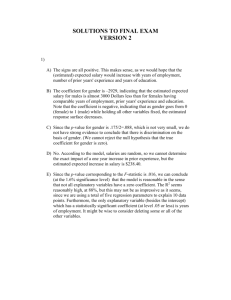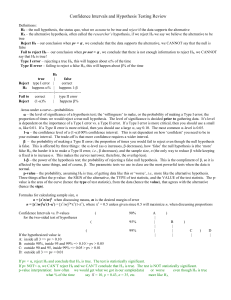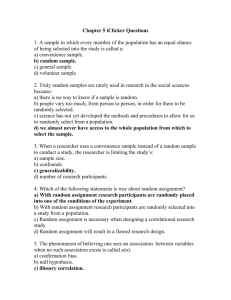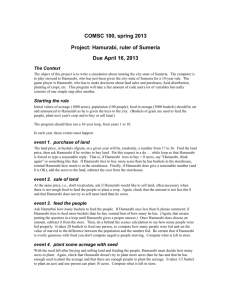MAT 170 – Confidence Interval and Hypothesis Test Review Problems
advertisement
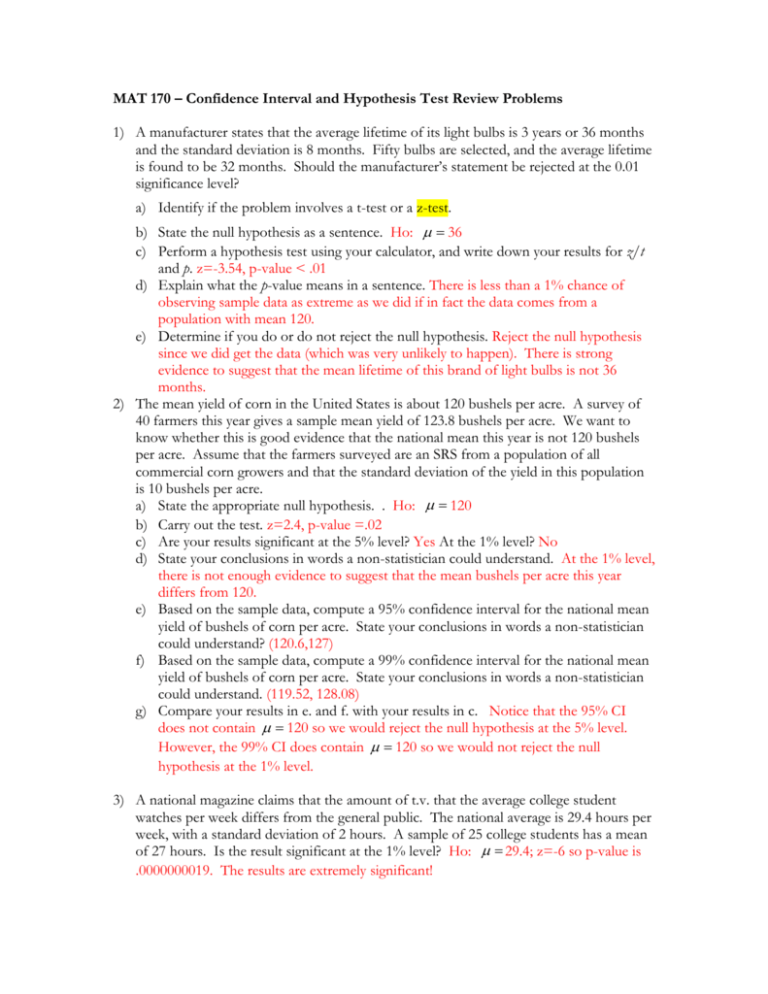
MAT 170 – Confidence Interval and Hypothesis Test Review Problems 1) A manufacturer states that the average lifetime of its light bulbs is 3 years or 36 months and the standard deviation is 8 months. Fifty bulbs are selected, and the average lifetime is found to be 32 months. Should the manufacturer’s statement be rejected at the 0.01 significance level? a) Identify if the problem involves a t-test or a z-test. b) State the null hypothesis as a sentence. Ho: 36 c) Perform a hypothesis test using your calculator, and write down your results for z/t and p. z=-3.54, p-value < .01 d) Explain what the p-value means in a sentence. There is less than a 1% chance of observing sample data as extreme as we did if in fact the data comes from a population with mean 120. e) Determine if you do or do not reject the null hypothesis. Reject the null hypothesis since we did get the data (which was very unlikely to happen). There is strong evidence to suggest that the mean lifetime of this brand of light bulbs is not 36 months. 2) The mean yield of corn in the United States is about 120 bushels per acre. A survey of 40 farmers this year gives a sample mean yield of 123.8 bushels per acre. We want to know whether this is good evidence that the national mean this year is not 120 bushels per acre. Assume that the farmers surveyed are an SRS from a population of all commercial corn growers and that the standard deviation of the yield in this population is 10 bushels per acre. a) State the appropriate null hypothesis. . Ho: 120 b) Carry out the test. z=2.4, p-value =.02 c) Are your results significant at the 5% level? Yes At the 1% level? No d) State your conclusions in words a non-statistician could understand. At the 1% level, there is not enough evidence to suggest that the mean bushels per acre this year differs from 120. e) Based on the sample data, compute a 95% confidence interval for the national mean yield of bushels of corn per acre. State your conclusions in words a non-statistician could understand? (120.6,127) f) Based on the sample data, compute a 99% confidence interval for the national mean yield of bushels of corn per acre. State your conclusions in words a non-statistician could understand. (119.52, 128.08) g) Compare your results in e. and f. with your results in c. Notice that the 95% CI does not contain 120 so we would reject the null hypothesis at the 5% level. However, the 99% CI does contain 120 so we would not reject the null hypothesis at the 1% level. 3) A national magazine claims that the amount of t.v. that the average college student watches per week differs from the general public. The national average is 29.4 hours per week, with a standard deviation of 2 hours. A sample of 25 college students has a mean of 27 hours. Is the result significant at the 1% level? Ho: 29.4; z=-6 so p-value is .0000000019. The results are extremely significant! 4) To study the birth weights of infants whose mothers smoke, a physician records the weights of 100 newborns whose mothers smoke. She finds that the average weight is 6.1 pounds with a standard deviation of 2.1 pounds. a) Find a 99% confidence interval that estimates the mean birth weight of children of smoking mothers. (5.55, 6.65) b) State your conclusions using language a non-statistician could understand. With 99% confidence, the mean weight for all infants whose mothers smoke is between 5.55 and 6.65 pounds. 5) An admissions counselor states that the average cost for one year’s tuition for all colleges in the state of Pennsylvania is $6250. A sample of 15 colleges is selected, and the average tuition is found to be $6801. Suppose that it is known that the standard deviation is $1075. Test the hypothesis, at the 1% level, to see if the average cost of tuition is $6250. Ho: 6250; z=1.99; p-value =.047. At the 1% level there is not enough evidence to suggest that the average cost of tuition for all colleges in PA differs from $6250. 6) The accompanying values are measured maximum breadths of male Egyptian skulls from different epochs. Changes in head shape over time suggest that interbreeding occurred with immigrant populations. Use the Kruskal-Wallis test with a 0.05 significance level to test the claim that the three samples come from identical populations. Include these steps: Write the null hypothesis as a sentence. Ho:= The Egyptian skulls all come from one population. Calculate H, showing all your work H=6.63 Decide if you reject or do not reject .01<p-value<.05 Write a final sentence that begins as either “There was a significant difference…” or “No significant difference was found …” 4000 BC 131 138 125 129 132 135 132 134 138 1850 BC 129 134 136 137 137 129 136 138 134 150 AD 128 138 136 139 141 142 137 145 137 7.Run an ANOVA test ( = 0.05) to compare income for various levels of education, using this data (given in thousands of dollars): high school: college: 6 30 15 30 24 31 24 39 30 60 40 74 62 grad. school: 27 49 58 78 83 102 You may assume that salaries are normally distributed. a. Why is the ANOVA test appropriate? Be specific.1 categ vs. 1 numer. Var; data come from one population which is normally distributed b. Write the null hypothesis as a sentence. Ho: There is no correlation between level of education and income levels. c. Give F and p values from the calculator, rounded to four places after the decimal. F=4.96; p-value =.02. d. The FACTOR df is __2___ and the ERROR df is ___16___. e. What is your conclusion? (reject or do not reject). Reject. There is statistically strong evidence to suggest that there is a correlation between education level and income.


